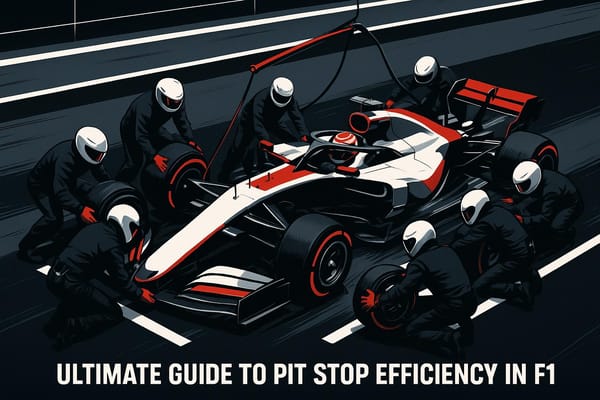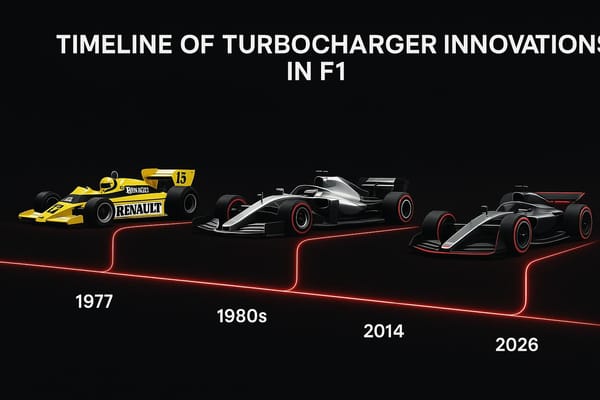How AI Predicts Perfect Pit Stop Timing
Explore how AI transforms pit stop strategies in Formula One, enhancing decision-making with real-time data analysis for improved race performance.

AI has revolutionized pit stop timing in Formula One, turning split-second decisions into precise, data-driven strategies. By analyzing millions of real-time data points from sensors on F1 cars, AI helps teams decide the best moment for a pit stop, improving race outcomes.
Key Takeaways:
- Real-time data: AI processes data from 300–600 sensors per car, tracking tire wear, fuel levels, weather, and competitor positions.
- Faster decisions: AI reduces pit stop analysis time by up to 80%, enabling teams to act within seconds.
- Success stories: Ferrari achieved a 2-second pit stop at the 2025 Saudi GP using AI-powered systems.
- Challenges: AI struggles with unpredictable events like safety cars or sudden weather changes but continues to improve with advanced simulations and predictive models.
AI in F1 doesn’t replace human expertise - it enhances it, allowing engineers to focus on strategy while AI handles data analysis. This collaboration is setting new standards in motorsport.
How AI Predicts Pit Stops
In today's Formula 1, AI plays a critical role in analyzing data to determine the best moments for pit stops. Building on the basics of pit stop strategy, AI fine-tunes these decisions with advanced data-crunching capabilities.
Types of Race Data
F1 cars are loaded with high-tech sensors that provide real-time information, which AI uses to optimize pit stop timing. These sensors track a variety of data, including:
- Real-time telemetry: Engine performance, brake temperatures, and aerodynamic loads.
- Tire metrics: Wear patterns, temperature, and grip levels.
- Environmental data: Track temperature, humidity, and chances of rain.
- Race position: Gap times, sector performance, and competitor locations.
- Fuel consumption: Current fuel levels and projected usage rates.
AI Processing Methods
AI systems use machine learning to sift through these data streams, identifying patterns and creating predictive models. The process involves multiple layers of analysis:
"Data is in the team's lifeblood. Every element of performance - how we run a race, how we develop a car, how we select and analyze drivers - it's all driven by data." – Christian Horner, CEO of Oracle Red Bull Racing
Modern AI tools can now complete aerodynamic simulations in just 8 hours, a task that used to take 4 days. This speed allows teams to quickly generate models for tire wear, simulate race scenarios, and predict competitor strategies. These insights are essential for making quick, informed decisions during the race.
Live Data Updates
The real advantage of AI in Formula 1 is its ability to adapt strategies on the fly. During a race, AI systems constantly:
- Monitor tire performance and update wear predictions.
- Track weather changes and predict their effects on grip.
- Analyze competitor pit stop strategies.
- Calculate the best moments for strategic stops.
A standout example of AI's impact was during the 2019 British Grand Prix. Mercedes used their data analysis system to perfectly time Lewis Hamilton's pit stop under a safety car, a move that secured his victory. This ability to integrate pre-race planning with real-time adjustments gives teams a significant edge, ensuring every decision is as precise as possible.
AI Advantages in Pit Stop Planning
AI's ability to process and analyze race data has brought a new level of sophistication to pit stop planning, giving teams a strategic edge during races.
Faster Timing and Precision
AI has drastically reduced the time it takes to analyze pit stop data. What used to take several minutes can now be completed in just 60-90 seconds. This efficiency enables track operations engineers to sync data up to 80% faster compared to older methods. The result? Teams can make quicker, more accurate decisions when every second counts.
Real-Time Strategy Adjustments
One of AI's standout features is its ability to process telemetry data in real time, allowing teams to adjust strategies on the fly. Andrew McHutchon, McLaren's Head of Data Science, highlights this:
"If it's a decision related to pitting, you may only have a third of a lap before the car passes the pit lane, and after that, you've lost your opportunity, so you need to be fast. You could have terabytes and terabytes to analyze, which could take half a day or more to answer just one question without AI."
This capability ensures teams can respond to sudden changes in race conditions without hesitation, pairing speed with precision.
Lower Risk in Decision-Making
AI significantly reduces the risks associated with pit stop decisions by offering data-driven insights. From monitoring tire pressure and engine performance to predicting competitor strategies and optimizing fuel usage, AI provides a wealth of actionable information. For example, Red Bull Racing uses Oracle's AI tools to balance speed and fuel efficiency, keeping them competitive on the track.
Clare Lansley, Chief Information Officer at Aston Martin F1, emphasizes the collaborative role of AI:
"AI isn't about replacing people. It's about empowering them. AI will handle the heavy lifting of data analysis and repetitive tasks, allowing engineers to focus on strategic decision-making and creative problem-solving. Ultimately, the human touch, combined with the power of AI, will be the winning formula."
Ferrari's use of Amazon SageMaker to create a virtual ground speed sensor showcases how AI can directly enhance vehicle performance, setting a higher standard for race strategies.
AI Success Stories in F1
AI has become a game-changer in Formula One, especially in the high-stakes world of pit stop timing. Recent races have shown how split-second decisions powered by AI can dramatically influence race outcomes.
2025 Saudi GP Analysis
The 2025 Saudi Arabian Grand Prix at the Jeddah Corniche Circuit provided a stunning example of how AI can redefine pit stop strategies. Scuderia Ferrari HP achieved a jaw-dropping 2-second flat pit stop for Charles Leclerc, marking their fifth consecutive fastest pit stop of the season. This incredible feat was made possible by their machine learning system developed in partnership with AWS.
Ferrari took their data capture to the next level by upgrading from two 25 fps cameras to four 120 fps cameras. This improvement allowed for faster and more precise decision-making, which is critical on Jeddah's challenging circuit. Coupled with real-time telemetry analysis, the team leveraged automated, centralized insights to fine-tune their pit stop strategy and deliver peak performance.
F1 Teams Using AI
Top Formula One teams have fully embraced AI, each tailoring it to meet their specific needs. Here's a look at how some of the leading teams are using AI to gain an edge:
| Team | AI Technology Partner | Key Implementation |
|---|---|---|
| Scuderia Ferrari HP | AWS | Machine learning for pit stop analysis with 80% faster data synchronization |
| Mercedes-AMG Petronas | G42 | Advanced telemetry analysis for track-specific optimizations |
| Oracle Red Bull Racing | Oracle Cloud | Race strategy optimization and fuel consumption analysis |
| McLaren | Various Partners | Digital twins for virtual testing and scenario simulation |
McLaren’s approach stands out for its focus on simulation. Dan Keyworth, their director of business technology, shared his perspective on AI's role:
"What AI allows us to do from a generative perspective is to actually game out more of those actual scenarios and go, 'What will happen?'"
The achievements of these teams highlight how AI is reshaping Formula One. They also open the door to exploring new challenges and opportunities for advancing the technology further. AI’s role in F1 is only growing, pushing the limits of what’s possible on and off the track.
AI Limits and Next Steps
AI System Constraints
AI has brought a new level of precision to pit stop timing in Formula One, but it’s not without its flaws. As datasets keep expanding, the added complexity can overwhelm systems, leading to less reliable predictions.
Here are some of the key challenges AI systems face:
| Challenge Type | Impact on Strategy | Limitation |
|---|---|---|
| Weather Changes | Alters tire strategies | Limited ability to adapt in real time |
| Safety Car Deployments | Forces strategy shifts | Hard to predict timing |
| Track Conditions | Affects pit stop windows | Complex correlation of variables |
| Strategic Errors | Requires quick replanning | Constrained decision-making processes |
These hurdles make it tough for current AI models to react to sudden, game-changing events during a race.
"I think there's always going to be that barrier. It's really hard to be able to tell that there's going to be a safety car this lap, and that this is then going to trigger some other stream of events." - Mariana Antaya, Data Scientist
Such limitations highlight the need for ongoing advancements in AI to better support race strategies. Each challenge tackled pushes the boundaries of what AI can achieve in this fast-paced environment.
Coming AI Improvements
Formula One teams are already working on refining AI systems to overcome these obstacles. Some of the key advancements in development include:
- Better pattern recognition to predict safety car deployments
- Enhanced risk analysis for managing unpredictable weather
- Advanced weather models integrating track temperature data
- Faster simulation speeds for real-time adjustments
One example of progress is McLaren's adoption of digital twins in October 2024. This technology allows for highly detailed simulations to fine-tune pit stop timing. Similarly, Aston Martin Aramco is using data lakes and machine learning to combine tire performance, weather conditions, and track data. This approach not only sharpens decision-making but also frees up engineers to focus on other critical tasks.
"AI is not there to replace anybody. AI is there to add to our data scientists and engineers and helps inform their decisions." - Edward Green, McLaren F1 Team head of commercial technology
These advancements reflect a collaborative approach, where AI serves as a powerful tool to complement human expertise rather than replace it.
Conclusion: AI's Role in Modern Racing
AI has reshaped pit stop strategies, swapping gut instincts for precise, data-driven decisions. With modern F1 sensor data fueling these insights, teams can now make critical calls with a level of accuracy that was once unimaginable.
Take McLaren, for example. By using generative AI, they can simulate countless race scenarios, preparing for almost anything that might happen on the track. Meanwhile, Aston Martin Aramco leverages vast data lakes that combine tire performance, weather conditions, and track specifics to fine-tune their strategies. Even aerodynamic simulations, which used to take four days, now wrap up in just eight hours. These advancements don’t just improve performance - they also save money.
The financial benefits are staggering. Teams have slashed issue detection time by 99%, translating into savings of about $18.7 million across 23 races. This efficiency frees up engineers to zero in on what matters most: enhancing car performance instead of getting bogged down in endless data analysis.
And the progress doesn’t stop here. Teams are already looking into advanced predictive analytics and autonomous systems to take precision to the next level. Clare Lansley, Aston Martin Aramco's chief information officer, highlights the impact of this shift:
"By adopting this tech, we are going to be able to free up multiple engineers so they can focus more acutely on car performance"
The collaboration between human expertise and AI is setting a bold new standard in Formula 1. Together, they’re making lightning-fast decisions based on millions of data points, pushing the boundaries of what's possible in modern motorsport.
FAQs
How does AI use real-time data to optimize pit stop timing in Formula One?
AI plays a pivotal role in Formula One by using real-time sensor data to pinpoint the perfect moments for pit stops. These sensors collect over 1.1 million data points every second, tracking vital metrics like tire temperatures, fuel levels, and overall car performance. By processing this telemetry data, AI predicts critical factors such as tire wear, fuel usage, and track conditions, helping teams make precise decisions about when to bring their cars in.
What makes AI even more impressive is its ability to adapt to unpredictable race scenarios, like sudden weather shifts or unexpected moves from competitors. It recalculates pit stop strategies in real time, ensuring teams lose as little time as possible while maintaining peak performance. This data-driven approach gives teams a competitive edge in the high-stakes world of Formula One.
What challenges does AI face when predicting the best pit stop timing during unpredictable race events like sudden weather changes or safety car deployments?
Challenges in Predicting Pit Stop Timing with AI
AI faces a tough task when it comes to predicting the best moments for pit stops, especially during unpredictable events like sudden weather shifts or safety car deployments. These scenarios can completely change race dynamics in real time. To stay effective, AI needs to process enormous amounts of telemetry data - such as tire wear, fuel levels, and track conditions - at lightning speed and adjust its predictions accordingly.
On top of that, the unpredictable strategies of rival teams and the on-the-spot decisions of drivers add another layer of complexity. These factors can heavily influence the timing and execution of pit stops. While advanced machine learning models allow AI to adapt to new data, the fast-moving, ever-changing nature of Formula One races can still push even the most advanced systems to their limits.
How do Formula One teams use AI to support human decision-making in race strategies?
How Formula One Teams Use AI
In Formula One, AI serves as a powerful assistant to human strategists, not a replacement. It handles massive amounts of data - like telemetry, weather predictions, and historical race stats - to uncover patterns and offer actionable insights. This helps teams make smarter, faster decisions during races.
That said, the ultimate decisions still rest with human experts. They factor in real-time track conditions, feedback from drivers, and the overall dynamics of the team. By blending AI's precision with the intuition and experience of seasoned strategists, teams craft strategies that are both grounded in data and flexible enough to adapt to the unpredictable nature of race day.




